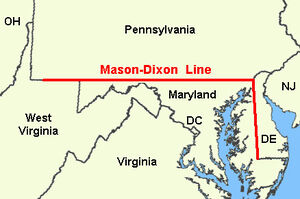Mason–Dixon line (nonfiction): Difference between revisions
(Created page with "The '''Mason–Dixon line''', also called the Mason and Dixon line or Mason's and Dixon's line, was surveyed between 1763 and 1767 by Charles Mason and Jeremiah Dixon in the r...") |
No edit summary |
||
| Line 1: | Line 1: | ||
The '''Mason–Dixon line''', also called the Mason and Dixon line or Mason's and Dixon's line, was surveyed between 1763 and 1767 by Charles Mason and Jeremiah Dixon in the resolution of a border dispute involving Maryland, Pennsylvania, and Delaware in Colonial America. It is still a demarcation line between four U.S. states, forming part of the borders of Pennsylvania, Maryland, Delaware, and West Virginia (part of Virginia until 1863). Later it became known informally as the border between the free (Northern) states and the slave (Southern) states. The Virginia portion was the northern border of the Confederacy. It came into use during the debate around the Missouri Compromise of 1820, when the boundary between slave and free states was an issue. It is still used today in the figurative sense of a line that separates the North and South politically and socially (see Dixie). | [[File:Original Mason-Dixon line.jpg|thumb|The original Mason–Dixon line.]]The '''Mason–Dixon line''', also called the Mason and Dixon line or Mason's and Dixon's line, was surveyed between 1763 and 1767 by Charles Mason and Jeremiah Dixon in the resolution of a border dispute involving Maryland, Pennsylvania, and Delaware in Colonial America. It is still a demarcation line between four U.S. states, forming part of the borders of Pennsylvania, Maryland, Delaware, and West Virginia (part of Virginia until 1863). Later it became known informally as the border between the free (Northern) states and the slave (Southern) states. The Virginia portion was the northern border of the Confederacy. It came into use during the debate around the Missouri Compromise of 1820, when the boundary between slave and free states was an issue. It is still used today in the figurative sense of a line that separates the North and South politically and socially (see Dixie). | ||
== See also == | == See also == | ||
* [[Diary (May 7, 2020)#Song_of_the_Day_for_Howard_Kranz]] | * [[Diary (May 7, 2020)#Song_of_the_Day_for_Howard_Kranz]] | ||
Revision as of 07:34, 7 May 2020
The Mason–Dixon line, also called the Mason and Dixon line or Mason's and Dixon's line, was surveyed between 1763 and 1767 by Charles Mason and Jeremiah Dixon in the resolution of a border dispute involving Maryland, Pennsylvania, and Delaware in Colonial America. It is still a demarcation line between four U.S. states, forming part of the borders of Pennsylvania, Maryland, Delaware, and West Virginia (part of Virginia until 1863). Later it became known informally as the border between the free (Northern) states and the slave (Southern) states. The Virginia portion was the northern border of the Confederacy. It came into use during the debate around the Missouri Compromise of 1820, when the boundary between slave and free states was an issue. It is still used today in the figurative sense of a line that separates the North and South politically and socially (see Dixie).
